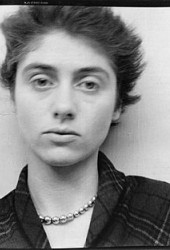Love involves a peculiar unfathomable combination of understanding and misunderstanding.
Diane Arbus (March 14, 1923 – July 26, 1971) was an American photographer.
Arbus famously worked to normalize marginalized groups and highlight the importance of proper representation of all people. She worked with a wide range of subjects including members of the LGBTQ+ community, strippers, carnival performers, nudists, dwarves, children, mothers, couples, elderly people, and middle-class families. She photographed her subjects in familiar settings: their homes, on the street, in the workplace, in the park—celebrating imagery that seem to reflect our deepest fears and most private wish. “She is noted for expanding notions of acceptable subject matter and violates canons of the appropriate distance between photographer and subject. By befriending, not objectifying her subjects, she was able to capture in her work a rare psychological intensity”. In his 2003 New York Times Magazine article, "Arbus Reconsidered," Arthur Lubow states, "She was fascinated by people who were visibly creating their own identities—cross-dressers, nudists, sideshow performers, tattooed men, the nouveau riche, the movie-star fans—and by those who were trapped in a uniform that no longer provided any security or comfort." Michael Kimmelman writes in his review of the exhibition Diane Arbus Revelations, "Her memorable work, which she did, on the whole, not for hire but for herself, was all about heart—a ferocious, audacious heart. It transformed the art of photography (Arbus is everywhere, for better and worse, in the work of artists today who make photographs), and it lent a fresh dignity to the forgotten and neglected people in whom she invested so much of herself."In her lifetime she achieved some recognition and renown with the publication, beginning in 1960, of photographs in such magazines as Esquire, Harper’s Bazaar, the London Sunday Times Magazine, and Artforum. In 1963 the Guggenheim Foundation awarded Arbus a fellowship for her proposal entitled, "American Rites, Manners and Customs". She was awarded a renewal of her fellowship in 1966. John Szarkowski, the director of photography at the Museum of Modern Art from 1962 to 1991, championed her work and included it in his groundbreaking 1967 exhibit New Documents along with the work of Lee Friedlander and Garry Winogrand. Her photographs were also included in a number of other major group shows.In 1972, a year after she died by suicide, Arbus became the first photographer to be included in the Venice Biennale where her photographs were "the overwhelming sensation of the American Pavilion. If one's natural tendency is to be skeptical about a legend, it must be said that all suspicion vanishes in the presence of the Arbus work, which is extremely powerful and very strange."The first major retrospective of Arbus’ work was held in 1972, a year after her death, at the Museum of Modern Art (MOMA) in New York City, where she lived for most of her life.” The retrospective was organized by John Szarkowski, who was a continuous supporter of her work. The retrospective garnered the highest attendance of any exhibition in MOMA's history to date. Millions viewed traveling exhibitions of her work in 1972–1979. The book accompanying the exhibition, Diane Arbus: An Aperture Monograph, edited by Doon Arbus and Marvin Israel and first published in 1972 has never been out of print
- quotations /
- quotes by Famous People /
- Diane Arbus
